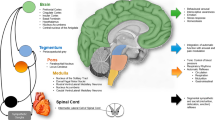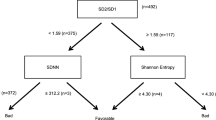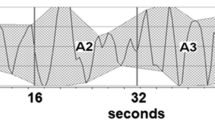Abstract
The sensitivity and specificity of heart rate variability (HRV) in the corroboration of brain death diagnosis in patients with acute traumatic intracranial lesions was evaluated in 20 patients with clinical criteria of brain death, nine patients in deep coma (Glasgow scale <7) and 18 normal controls, all age matched. The electrocardiogram was sampled at 650 Hz and several parameters of HRV were calculated, in both time and frequency domains. The HRV parameters were significantly lower in the brain death group compared with the deep coma group. Linear discriminant analysis between brain death and deep coma patients was performed on a data set made of nine randomly selected patients with clinical criteria of brain death and nine patients in deep coma. Cross-validation was performed on the remaining 11 patients with clinical criteria of brain death. All patients in the data set were correctly classified (sensitivity and specificity of 100%). All patients in the cross-validation set were correctly classified (sensitivity of 100%). Further studies are necessary to evaluate the specificity of the method in the independent set of deep coma patients and in the follow-up of comatose and vegetative patients to identify irreversibility of HRV. Nevertheless, these results suggest that HRV analysis constitutes a fully sensitive and specific method for assessing brain death in potential organ donors with acute traumatic lesions of the brain. This fast, quantitative and bedside method seems very promising for the early confirmation of brain death, which is an important factor for the success of transplantation procedures and could have a high predictive value of brain death in comatose patients with brain injuries without fully diagnostic criteria.
Similar content being viewed by others
References
Woolf PD, Hamill RW, Lee LA. The predictive value of catecholamines in assessing outcome in traumatic brain injury.J Neurosurg 1987;66: 875–882.
Clifton GL, Robertson CS, Kyper K. Cardiovascular response to severe head injury.J Neurosurg 1983;59: 637–643.
Frank JI, Ropper AH, Zuniga G. Acute intracranial lesions and respiratory sinus arrhythmia.Arch Neurol 1992;49: 1200–1203.
Scwartz G, Pfurtscheller G, Lischer G, List WF. Quantification of autonomic activity in the brainstem in normal, comatose and brain dead subjects using heart rate variability.Functional Neurology 1987;2: 149–154.
Guidelines for the determination of death. Report of the Medical Consultants on the Diagnosis of Death to the President's Commission for the study of Ethical Problems in Medicine and Biomedical Behavioral Research. In: Rubenstein E, Federman D, eds.Scientific American Medicine, ch. 8, part VII. New York, 198; 1–4.
Teasdale G, Jennett B. Assessment of coma and impaired consciousness. A practical scale.Lancet 1974;ii: 81–84.
Costa O, Lago P, Rocha AP, et al. Heart rate variability in 24-hour Holter recordings. Comparative study between short and long term time and frequency domain analysis.J Electrocardiol 1994;27: 251–254.
Goldstein B, DeKing D, DeLong D, et al. Autonomic cardiovascular state after severe brain injury and brain death in children.Critical Care Medicine 1993;21: 228–233.
Lacquanity LG, Irone M, Barbacini S, et al. Heart rate variability and severe brain damage: preliminary data.Intern J Clin Monit and Computing 1993;10: 181–185.
Kita Y, Ishise J, Yoshita Y, et al. Power spectral analysis of heart rate and blood pressure oscillation in brain-dead patients.Journal of the Autonomic Nervous System 1993;44: 101–107.
Kleiger RE, Stein PK, Bosner MS, Rottmasn JN. Time domain measurements of heart rate variability.Cardiol Clinics 1992;10: 487–498.
Ori Z, Monir G, Weiss J, Sayouni X, Singer DH. Heart rate variability. Frequency domain analysis.Cardiol Clinics 1992;10: 499–533.
Akselrod S, Gordon D, Ubel FA. Power spectral analysis of heart rate fluctuation: a quantitative probe of beat-to-beat cardiovascular control.Science 1981;213: 220–222.
Bernardi L, Perlini S, Salvucci F, et al. Does autonomic modulation explain heart rate variability in all conditions? In: Di Rienzo M, et al., eds.Blood Pressure and Heart Rate Variability. Amsterdam: IOS Press, 1993; 143–152.
Sands KEF, Appel ML, Cohen RJ. Power spectrum analysis of heart rate variability in human cardiac transplant recipients.Circulation 1989;79: 76–78.
Carvalho MJ, Man in't Veld AJ, Costa O, et al. Spectral analysis of heart rate as an assessment of autonomic function in famillial amyloid polyneuropathy.J Hypertens 1991;9(6): S62-S63.
Author information
Authors and Affiliations
Rights and permissions
About this article
Cite this article
Freitas, J., Puig, J., Rocha, A.P. et al. Heart rate variability in brain death. Clinical Autonomic Research 6, 141–146 (1996). https://doi.org/10.1007/BF02281900
Received:
Accepted:
Issue Date:
DOI: https://doi.org/10.1007/BF02281900




